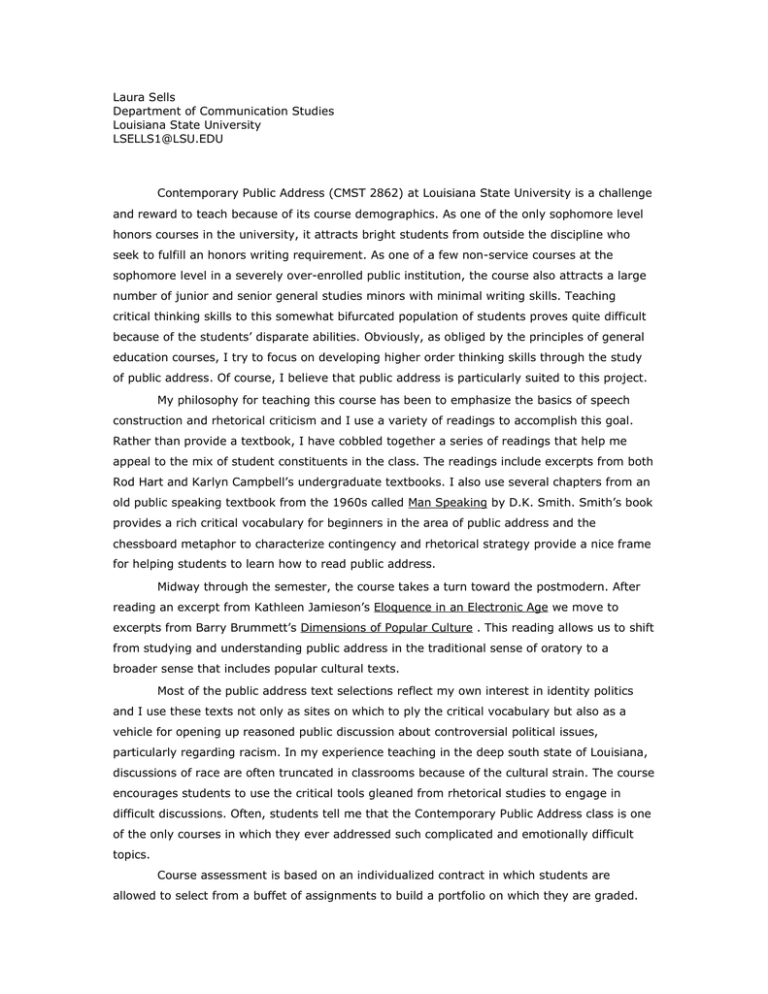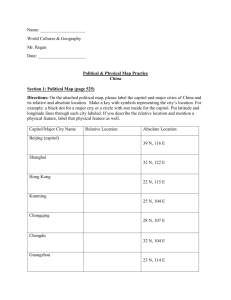Laura Sells Department of Communication Studies Louisiana State University
advertisement

Laura Sells Department of Communication Studies Louisiana State University LSELLS1@LSU.EDU Contemporary Public Address (CMST 2862) at Louisiana State University is a challenge and reward to teach because of its course demographics. As one of the only sophomore level honors courses in the university, it attracts bright students from outside the discipline who seek to fulfill an honors writing requirement. As one of a few non-service courses at the sophomore level in a severely over-enrolled public institution, the course also attracts a large number of junior and senior general studies minors with minimal writing skills. Teaching critical thinking skills to this somewhat bifurcated population of students proves quite difficult because of the students’ disparate abilities. Obviously, as obliged by the principles of general education courses, I try to focus on developing higher order thinking skills through the study of public address. Of course, I believe that public address is particularly suited to this project. My philosophy for teaching this course has been to emphasize the basics of speech construction and rhetorical criticism and I use a variety of readings to accomplish this goal. Rather than provide a textbook, I have cobbled together a series of readings that help me appeal to the mix of student constituents in the class. The readings include excerpts from both Rod Hart and Karlyn Campbell’s undergraduate textbooks. I also use several chapters from an old public speaking textbook from the 1960s called Man Speaking by D.K. Smith. Smith’s book provides a rich critical vocabulary for beginners in the area of public address and the chessboard metaphor to characterize contingency and rhetorical strategy provide a nice frame for helping students to learn how to read public address. Midway through the semester, the course takes a turn toward the postmodern. After reading an excerpt from Kathleen Jamieson’s Eloquence in an Electronic Age we move to excerpts from Barry Brummett’s Dimensions of Popular Culture . This reading allows us to shift from studying and understanding public address in the traditional sense of oratory to a broader sense that includes popular cultural texts. Most of the public address text selections reflect my own interest in identity politics and I use these texts not only as sites on which to ply the critical vocabulary but also as a vehicle for opening up reasoned public discussion about controversial political issues, particularly regarding racism. In my experience teaching in the deep south state of Louisiana, discussions of race are often truncated in classrooms because of the cultural strain. The course encourages students to use the critical tools gleaned from rhetorical studies to engage in difficult discussions. Often, students tell me that the Contemporary Public Address class is one of the only courses in which they ever addressed such complicated and emotionally difficult topics. Course assessment is based on an individualized contract in which students are allowed to select from a buffet of assignments to build a portfolio on which they are graded. All the assignments are writing-intensive, ranging from critical essays to essay exams to journals. Ironically, despite the freedom to build an individualized portfolio, students typically select the standard “two exams and a paper” package. One particular assignment I’d like to share comes from the second portion of the class. After reading selections from Brummett, the class makes a field trip to the state capitol. The attached assignment sheet is a list of questions to stimulate discussion, critical essays, and journal entries. During the field trip, we prowl the capitol together, and then we share lunch on the lawn and debrief. The activity is popular with the students. Although the questions are specific to the Louisiana Old State Capitol and the readings for my particular course, I’m an enthusiastic supporter of class field trips to public monuments for the public address class. Experiential learning helps students to bring public address outside the classroom to the real world and allows them to grow into critics through multiple channels of learning, appeals to multiple learning styles, and they -enjoy- it. Additionally, visiting public monuments teaches them that public address exists outside the boundaries of the written page (or the fixed speech text) and helps to illustrate the way that rhetoric works in seemingly innocent and innocuous sites. This is especially true for the Old State Capitol trip because most students remember their elementary school visits to the site. When the students reflect on the rhetorical meaning embedded both subtly and overtly in the capitol building, they re-think the innocence of their education. Because our site is a public monument to citizenship, students critically re-think the ways in which they are taught to be public citizens. The course readings, speech texts, grade contracts, and a host of resources are all available on the class website at http://www.voxygen.net/cpa. Field Trip to Old State Capitol As you visit the capitol, be sure that you pay attention to the following issues and concepts from class. In doing this assignment you need to 1. Apply these questions to the entire "capitol" and "capitol experience" and 2. Select ONE exhibit and apply these questions again. You may use these questions as journal entries or as a starting point for a critical paper. Think about these questions as you move through the capitol and briefly jot down notes for your answers. In class on Tuesday we will "debrief" from the experience. You will be awarded 10 participation points for the field trip. Bring your worksheet to class on Tuesday to receive credit. As you explore the capitol and its exhibits, pay specific attention to the following issues: 1. What kind of knowledge or literacy do you need to "read" the capitol? 2. The relationship between form (structure) and content of the entire building and of individual exhibits. What is the relationship between the physical structure and presentation of the building and the content/message it promotes? 3. What are the different boundaries between text and context (discrete and dispersed, original and new, etc. – From Brummett) 4. The meanings and struggles over meaning that are explicit and implied. What kinds of tactics are used to make meaning. See if you can see some dominant themes across the exhibits. Discussion, Journal, or Paper Prompts: 1. Spend some time studying the capitol’s crowd control practices and the ways that both visitors and staff are "contained." What are the strategies used for controlling bodily movement through space? In what ways are you turned into a useful/docile body? What are the various body_object articulations and what do they articulate you with? How? 2. What is the ideal user of the capitol’s text? What is the subject position that the capitol creates? What are the characteristics or features of the ideal user? List at least 10 characteristics and then talk about what sort of subject position is created and what strategies are used to create it. 3. What are some ways to use the text of the capitol "differently" than the ideal way (i.e., what kinds of inflected or oppositional readings are possible? Where is there room to resist the preferred reading? Observe visitors and determine how they are using the text of the capitol. In what ways do they follow the ideal way or create their own ways? 4. What is the narrative that the capitol presents? In other words, what sort of Master Narrative does the Capitol envision for the world? for the future? How does the narrative function rhetorically? What is revealed and what is concealed by the narrative? 5. Think about Hart’s discussion of the functions of rhetoric. What rhetorical functions are served by the Capitol? 6. Think about the basic guidelines established by Campbell for analyzing a rhetorical text. What structure, persona, tone, evidence, etc. is presented in the Capitol and what rhetorical purpose is being advocated?


